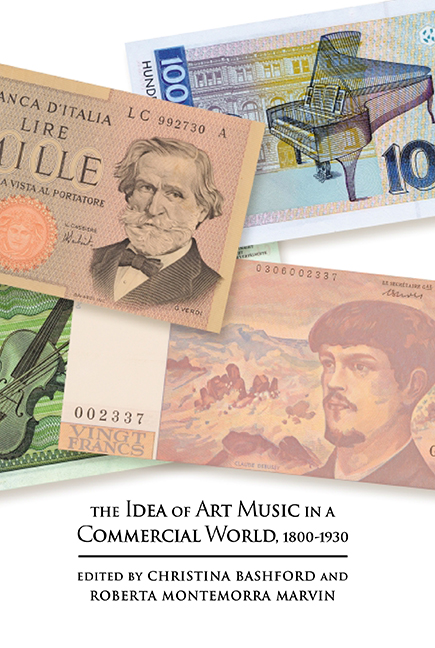Book contents
- Frontmatter
- Contents
- List of Figures
- List of Tables
- Notes on Contributors
- Acknowledgements
- A Note on Translations
- Bibliographic Abbreviations
- Introduction: The Idea of Art Music in a Commercial World
- PART I PUBLISHERS
- PART II PERSONALITIES
- PART III INSTRUMENTS
- PART IV REPERTOIRES
- PART V SETTINGS
- Index
- Music in Society and Culture
7 - ‘What the Piano[la] Means to the Home’: Advertising of Conventional and Player Pianos in the Saturday Evening Post and Ladies’ Home Journal, 1914–17
Published online by Cambridge University Press: 27 May 2021
- Frontmatter
- Contents
- List of Figures
- List of Tables
- Notes on Contributors
- Acknowledgements
- A Note on Translations
- Bibliographic Abbreviations
- Introduction: The Idea of Art Music in a Commercial World
- PART I PUBLISHERS
- PART II PERSONALITIES
- PART III INSTRUMENTS
- PART IV REPERTOIRES
- PART V SETTINGS
- Index
- Music in Society and Culture
Summary
WHILE thumbing through the Saturday Evening Post in mid September 1917, the average American reader might have stumbled upon the following from a full-page account by the fictive John Smith, Merchant and Pianist:
While I was enjoying an after-dinner cigar and a magazine article the other evening, Mother took up my evening paper as usual. Presently she spoke. ‘John’, she said, ‘don't you want to give us a little music?’
‘Surely’, I said, going over to the music cabinet. ‘What shall I play? Classical, popular, or what?’
‘Oh, play anything’, she answered, ‘I like it all.’ So I selected my program and carried the rolls over to the piano. Two pieces of Nevin’s: ‘A Venetian Love Song’ and the ‘Gondolier’. Chopin's ‘Ballade in A Flat’, Liszt's ‘12th Hungarian Rhapsodie’, Beethoven's ‘Sonata Pathetique’ [sic] (the Andante Movement), a ‘Romance’ by Pascal, a Medley of Popular Broadway Hits, and a rattling new fox-trot by Ted Eastwood.
I adjusted the first roll – the ‘Venetian Love Song’ – put my feet on the treadles, my hands on the expression levers and – lo! The music had me.
Paragraphs later, after extolling the expressive possibilities of the Pianola-brand player piano, spokesman Smith urged readers to ‘Trade in your old, silent piano’ and take up active music-making at the mechanical player piano. However, even as the advertisement's domestic tableau was promoting the new music commodity, its messaging was alternately embracing and throwing into question deep-seated cultural norms around the conventional (hand-played) ‘old, silent piano’, an instrument still widely purchased, played and displayed in upper-, middle- and (increasingly) working-class homes.
Much existing scholarship on the mechanical piano comments on its advertising, frequently highlighting the strategic ways in which its earlytwentieth- century promotion piggybacked on the conventional piano's accepted place in the American parlour. In point of fact, the often-cited themes linking the two instruments’ identities, including ‘middle-classness’, family (with the noted addition of men in the case of mechanical pianos) and music appreciation, are readily evident in the Pianola ad referenced above. At the same time, the mechanical piano is commonly implicated for its catalytic role in broad changes that we now (often negatively) link to the accelerated commodification of music in early-twentieth-century American musical life, including the shift away from amateur music-making and towards passive music listening and mass-produced, consumption-based musical experiences.
- Type
- Chapter
- Information
- The Idea of Art Music in a Commercial World, 1800-1930 , pp. 152 - 177Publisher: Boydell & BrewerPrint publication year: 2016

